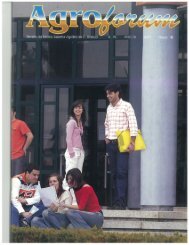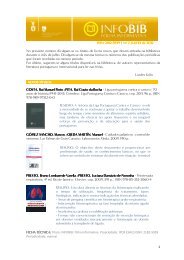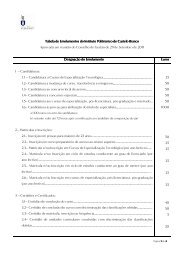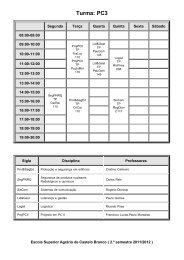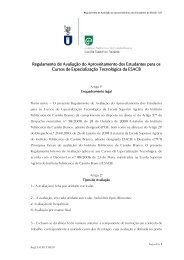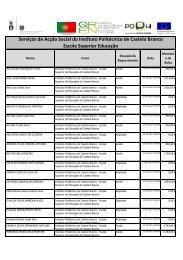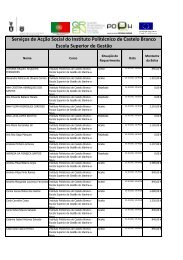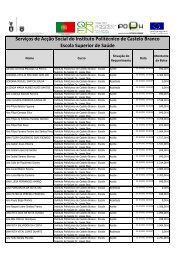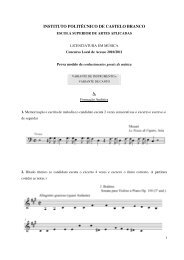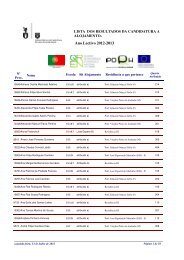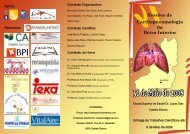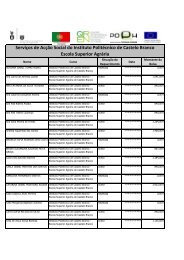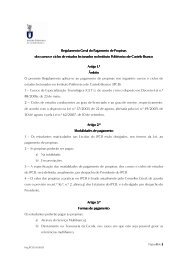N.º 24 - PDF - Instituto Politécnico de Castelo Branco
N.º 24 - PDF - Instituto Politécnico de Castelo Branco
N.º 24 - PDF - Instituto Politécnico de Castelo Branco
Create successful ePaper yourself
Turn your PDF publications into a flip-book with our unique Google optimized e-Paper software.
Efect on Microbial Growth in the Rumen<br />
and Fermentation Kinetics of Feedstuffs<br />
Un<strong>de</strong>r Different Levels of Nitrogen<br />
Sérgio Oliveira Dias Santo Freire *<br />
INTRODUCTION<br />
A new report from the Food and Agriculture Organization<br />
of the United Nations (Steinfield et al., 2006) consi<strong>de</strong>rs livestock<br />
production as one of the major causes of the world’s most<br />
pressing environmental problems. To optimize the rumen microbial<br />
system, feeds must be characterized according to their<br />
ingestive and <strong>de</strong>gradation behaviour in the rumen (Tamminga,<br />
1996). Improving the efficiency of feed nitrogen (N) utilization<br />
is the most effective means to reduce nutrient losses<br />
(Jonker et al., 2002). The challenge is to establish the minimal<br />
amount of protein required by dairy cows to achieve optimal,<br />
but not necessarily maximal, milk production.<br />
This study was <strong>de</strong>signed to investigate the minimal request<br />
of N for normal microbial growth using in vitro gas production<br />
technique, in different feedstuffs. As well as, the effects of<br />
different levels of N on the in vitro fermentation kinetics.<br />
MATERIALS AND METHODS<br />
Feed samples and chemical analysis<br />
Using the gas production technique, six feedstuffs<br />
(maize, maize gluten feed (MGF), soybean meal (SBM),<br />
citrus pulp, tapioca and wheat) were evaluated. About 500<br />
mg of sample were weighed into 300 ml serum bottles<br />
and incubated with 60 ml of buffered rumen fluid (RF).<br />
Each sample was incubated in RF mixed with an anaerobic<br />
buffer/mineral solution in different dilutions, 1:2 and 1:9<br />
(v/v), with or without N present in the buffer (NN or N-free<br />
incubations). The dilution of RF with buffer had the aim to<br />
reduce the content of N, and thus obtain different levels of<br />
it in the medium. With the purpose to maintain the buffer<br />
capacity in N-free incubations, ammonium bicarbonate in<br />
Table 1 - Chemical composition (%) of substrates used for in vitro experiments.<br />
Sample<br />
Maize MGF SBM Citrus Tapioca Wheat<br />
DM * 875.7 860.7 909.4 840.6 871.3 870.0<br />
Cru<strong>de</strong> protein (%) 9.6 21.5 47.0 6.5 3.0 13.0<br />
NDF (%) 14.5 42.5 16.1 37.0 15.4 12.0<br />
ADF (%) 2.6 9.9 8.0 19.0 6.4 2.6<br />
Starch+Sugar (%) 75.0 25.5 14.5 25.7 75.0 71.0<br />
DM = dry matter; NDF = neutral <strong>de</strong>tergent fibre; ADF = acid <strong>de</strong>tergent fiber; *- g/kg;<br />
MGF = maize gluten feed; SBM = soybean meal; citrus = citrus pulp.<br />
n.º <strong>24</strong> Ano 18, 2010 11



